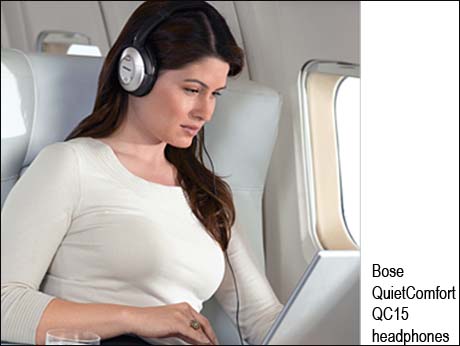
July 28, 2014: An article in GigaOm last week alerted us to the fact that Audio electronics leaders, Bose has filed a complaint in a US federal court, claiming copyright infringement of its multiple patents in noise cancelling headphone technology, by Apple-owned Beats’ “Studio Wireless” and other brands .
It claims the patents were issued between 2004 and 2013, and include US Patent 6,717,537 for “Method and Apparatus for Minimizing Latency in Digital Signal Processing Systems” and US Patent 8,345,888 for “Digital High Frequency Phase Compensation.”
The complaint provides a history of Bose’s work in developing active noise reduction (“ANR”), “a technique to reduce unwanted noise by introducing a second sound source that destructively interferes with the unwanted noise. ANR headphones typically use at least one microphone to detect unwanted ambient noise.”
While the legal suit as such may not be much interest to us, we thought the detailed narration of how noise cancelling technology was developed over the last half century , would interest our readers who are increasingly faced with a choice of noise cancelling headphone options:
For almost 50 years, Bose has made significant investment in the research,.development, engineering, and design of proprietary technologies now implemented in its products, such as noise cancelling headphones. Bose’s current line of noise cancelling headphones, for example, embodies inventions protected by at least 36 U.S. patents and applications (22 patents and 14 pending applications).
How it all began:During a 1978 flight to Boston returning from Zurich, Dr. Bose was trying out a 12.new set of airline-supplied headphones and found that the experience was a great disappointment to him, as the fidelity benefits of the new headphones, compared to the older pneumatic tube phones, were masked by significant audible cabin noise and by the distortion that resulted from increasing the headphone volume to overcome this noise. On that flight, Dr. Bose formulated the basic concept and technology for a headphone that would not only reproduce speech and music with high fidelity, but also simultaneously act to significantly reduce unwanted cabin noise. Upon his return, Dr. Bose initiated a research program to work on this problem.
Early research centered on building models to validate the concept and to allow study of the materials and transducers needed to make the system work. As knowledge increased, Bose engineers began to consider applications for the technology. This technology is known as active noise reduction (“ANR”), also known as active noise control.
ANR is a technique to reduce unwanted noise by introducing a second sound source that destructively interferes with the unwanted noise. ANR headphones typically use at least one microphone to detect unwanted ambient noise, and the headphone speaker produces sound waves of reverse phase to destructively interfere with the unwanted sound.
Over the next several years, a series of prototypes were built for the U.S. Air Force, the U.S. Army and, in 1986, for the experimental Voyager aircraft, in a privately sponsored, non-stop around-the-world flight.
In 1989, Bose Corporation introduced the first commercially available active noise reduction headset. This product was designed for the aviation industry for communication in light aircraft and helicopters. In 1991, the U.S. Air Force selected Bose Corporation to produce an Acoustic Noise Cancelling headset for flight helmets and, in 1993, the Combat Vehicle Crewman (CVC) headset went into production for the U.S. Army. The contract for the Performance Improved Combat Vehicle Crewman (PICVC) headset was renewed and these headsets are used by the U.S. Army on Abrams Tanks and Bradley Fighting Vehicles. U.S. Air Force pilots flying the C-130 6 and other aircraft also have been outfitted with Bose active noise reduction headsets. Product improvements were introduced in 1995 with the Acoustic Noise Cancelling headset Series II, which was awarded “Product of the Year” by the Aircraft Owners and Pilots Association (AOPA). In 1998, the Bose Aviation Headset X was introduced, offering a breakthrough in performance with Bose’s proprietary TriPort headphone structure.
In 2004, Bose Corporation introduced the TriPort Tactical Headset, which was employed by infantry soldiers operating military Humvees, cargo trucks, and other wheeled vehicles.
In 2013, Bose Corporation introduced the T5 Tactical Headset, which allows dismounted soldiers to continue to have the benefits of Bose’s technology while away from their vehicle, among other advances.
Military application trickles down to civilian use: Bose Corporation has leveraged its research in military and commercial noise reduction for consumer applications. The QuietComfort Acoustic Noise Cancelling headphones were first introduced in 2000.
In 2003, Bose Corporation debuted the QuietComfort 2 headphone to critical acclaim, offering an unprecedented combination of noise reduction, audio performance, and comfortable fit in a more convenient around-the-ear headphone.
In 2006, the product line was extended with the introduction of the QuietComfort 3 headphones offering the same level of performance as its predecessor in a smaller, more portable on-ear design.
In 2009, Bose introduced the QuietComfort 15 headphones, which were widely considered to provide superior noise cancellation compared to any other consumer on-ear headphones currently available. In 2013, Bose introduced the QuietComfort 20 and 20i headphones (“QC20”), which marked both the first in-ear Acoustic Noise Cancelling headphone from Bose and the first mass-market use of digital technology in a Bose Acoustic Noise Cancelling headphone.
In 2013, Bose introduced the QuietComfort 20 and 20i headphones (“QC20”), which marked both the first in-ear Acoustic Noise Cancelling headphone from Bose and the first mass-market use of digital technology in a Bose Acoustic Noise Cancelling headphone.